
Wildflower area at Foss Park Hospital
On this page
Foreword
A Green Plan forms a key part of a sustainable healthcare strategy to ensure services remain fit for purpose today and for the future. It helps us to address national priorities such as carbon reduction, identify waste reduction opportunities and financial savings. We can only achieve this through balancing the three pillars of sustainability (financial, social and environmental). By encouraging sustainable development in all its forms, the Trust will play its part as a key regional anchor organisation and continue to take positive steps to mitigate the effects of its activities on the environment and build on the strong partnership and coproduction plans that are intrinsic to Our Journey to Change. Our Green Plan continues to align with our Journey to Change in the following ways:
- We will co-create high quality care: Our processes will help staff, patients and partners to take part in and shape powerful sustainable development and climate action as part of our commitment to offer the highest quality of care to our communities. Achieving the best value possible will support provision of sustainable clinical services.
- We will be a great employer: Our green plan will help to minimise the adverse impacts on the environment for colleagues and help to safeguard and secure wider social, economic and environmental benefits for the community.
- We will be a trusted partner: Our green plan is helping us to collaborate; across organisations, places and systems; to improve value and achieve shared goals.
This Green Plan is a refreshed version of our 2022 document and includes updates in guidance and legislative drivers along with showcasing some of our achievements so far on our sustainability journey. We have reflected on our progress to date and are committed to working towards the objectives set out in this Green Plan. Our first Green Plan was launched in 2022 and we are proud of the achievements made by our hard working and committed colleagues.
We have faced significant challenges in the last 3 years, in areas such as recruitment and in accessing funding for new investments, and this has had some impact on progress against our Green Plan. However, we have had some notable successes including:
- Successfully bidding to obtain access to external capital funding to take forward energy reduction projects – hugely positive given our especially challenging NHS financial context, within which access to capital funding has become severely limited, and
- Strengthening our governance processes to support staff to get involved with this important work.
We are reducing our carbon emissions from the baseline year but recognise that we have a long way to go to achieve our targets. Our vision is to achieve net zero by 2040, and we all have an important role in this. This plan sets out our next steps and we are pleased to present our updated Green Plan for the next three years.

Liz Romaniak, Director of Finance, Estates & Facilities
Introduction
Our previous Green Plan ran from April 2022 to March 2025 and was formed around nine areas of focus in line with guidance from NHS England. NHS guidance issued during late 2024/25 asked us to update our Green Plans by 31 July 2025. In this Green Plan refresh we will review our progress so far and set out the next three years in our journey towards achieving net zero by 2040. The plan will continue to align with key requirements that have been developed by NHS England in the Delivering a Net Zero NHS Strategy but will also include the requirements set out in the Estates Net Zero Delivery Plan, Net Zero Travel and Transport Strategy and Net Zero Supplier Roadmap.
About us
At Tees, Esk and Wear Valleys NHS Foundation Trust (TEWV) we provide a range of inpatient community mental health and learning disability services. We serve a population of just over two million people across County Durham, the Tees Valley, City of York and most of North Yorkshire. Our populations include the largest concentration of armed forces personnel in the UK and our adult inpatient eating disorder services and adult secure (forensic) wards serve the whole of the North East and North Cumbria. Our Trust now has around 8,100 staff working out of more than 90 sites and our annual income exceeds £500 million.
Why do we need a green plan?
TEWV is committed to deliver the Long-Term Plan, NHS Standard Contract and the specific recommendations in the Operational Planning Guidance and ‘Delivering a Net Zero NHS’ report, all of which have informed our Green Plan and continue to shape our vision.
There are several key legislative drivers for change, and specific guidance as to why we need this Green Plan:
- The Paris Agreement 2015 – global, legally binding international treaty with goal of limiting global temperatures to below 2oC.
- Climate Change Act 2008 – legally binding UK Government targets for reduction of carbon emissions. The NHS has a duty to respond to meet these targets which are enshrined in law.
- Net Zero by 2050 – binding target set by UK Government.
- The Environment Act 2021 – legally binding targets driven by improving air and water quality. Public bodies held to account on environmental obligations.
- Delivering a Net Zero NHS statutory guidance – sets out target of net zero by 2040 with duties on all Trusts to contribute.
- Health and Care Act 2022 – the NHS became the first health system to embed net zero targets outlined in the delivering a Net Zero NGHS guidance into legislation.
- Care Quality Commission (CQC) – Well Led – staff and leadership should be aware of threats and be educated and empowered to help reduce impacts.
Our Green Plan Vision
Our vision remains the same and is focussed on:
- Net Zero: resource consumption and Greenhouse Gas (GHG) emission reductions that align with NHS net zero targets.
- Climate Resilience: reducing the environmental impact of our activities and providing a basis for us to become a climate change-resilient organisation.
- Social Value: actions that leverage our role as a place-based anchor institution to accomplish social value.
Our progress so far
So where are we now, what progress has been made in the last three years and what are the future plans to support us on our journey? We want to build on our actions to date, so progress in the nine areas of focus is summarised below:
System leadership and workforce
A new Energy and Sustainability Manager joined the trust in June 2024 with delivery of the Green Plan being a key focus of the role. The Trust Sustainability Group was reconvened in August 2024 and meets quarterly to review and progress the Green Plan action plan. Progress is reported six monthly to the Executive Directors Group (formerly Executive Strategy and Resources Group) with periodic assurance into the Resources and Planning Committee. Working groups have been set up, with core membership from Sustainability Group members and wider trust staff. We are working with the Communications team to establish a Green Plan staff volunteer network with a dedicated Teams channel and monthly drop-in Teams sessions in development. We continue to work closely with our regional partners to share good practice and enhance delivery of Green Plans across the NHS. Work to identify external funding opportunities for reducing building energy use has been a particular focus and we have been in a position to submit bids to a number of competitive funding schemes with some notable successes.
Sustainable Models of Care
The Trust has worked with the University of York to develop and submit an outline proposal for National Institute of Health and Care Research (NIHR) funding for a project to identify which parts of the mental health care pathway have the highest carbon footprint and to explore whether alternative approaches, such as more care in the community, or better medicines management, can help to reduce emissions whilst maintaining standards of care. Discussions are in progress to integrate Sustainable Quality Improvement (SusQI) elements into existing Quality Improvement programmes. Working group membership has been established with further input from across the Care Groups being a key aim of this workstream.
Digital Transformation
A working group has been established and actions are progressing with a focus on digital and remote appointments and engaging staff and patients in digital care channels.
Travel and transport
A regional project funded by the North East Combined Authority (NECA) to provide a 2 year fully funded travel survey, scoping study and analysis for Lanchester Road Hospital is in progress. We are continuing to develop travel plans across our sites and are using the Modeshift platform as a tool to support this work. Knowledge sharing with our regional partner trusts is helping to standardise work in this area, and engagement with local and combined authorities will be key to progressing further. Business mileage is monitored and progress towards decarbonising our fleet of vehicles is ongoing. This is supported by a network of 80 electric vehicle charging points across the Trust.
Estates and facilities
Energy and water
In the last two years, two successful bids were made to the NHS Energy Efficiency Fund (NEEF):
- In 2024, LED lighting upgrades for Lanchester Road Hospital, Acklam Road Hospital, Springwood, Auckland Park Hospital and Cross Lane Hospital were successfully delivered.
- In 2025, funding was granted for LED lighting upgrades at Roseberry Park Hospital and a Building Management System (BMS) upgrade at Cross Lane Hospital. The project value was £350k with expected carbon savings of 80 tonnes CO2e.
Following the announcement of a Great British Energy Solar Fund opportunity and submission of expression of interest for several solar projects for delivery in 2025/26, funding for Roseberry Park Hospital and Acklam Road Hospital totalling £1.2 million was confirmed in March 2025. This is expected to save 140 tonnes CO2e each year.
We will review opportunities for consultancy funding to support development of Heat Decarbonisation Plans for our sites. The previous Low Carbon Skills Fund (LCSF) bid in April 2024 met the required standard, but the random allocation rank it was assigned sat outside the funding available on that occasion. We will continue to look for sources of funding in this area. We are continuing to engage with regional partners on potential for heat networks as part of future decarbonisation. Current networks under discussion are deep geothermal for Lanchester Road Hospital, hydrogen for Roseberry Park and a low carbon district heat network for Foss Park Hospital.
Waste and recycling
Data on food waste is being collected by Hotel Services in line with national guidance and reporting requirements. The Waste Manager has developed a food waste recycling scheme to meet the requirements of the new Simpler Recycling legislation which came into force for businesses on 1st April 2025. A new contract for the supply of pre-prepared inpatient meals is expected to reduce food waste by accommodating smaller pack sizes.
Work to move clinical waste for alternative treatment into the offensive waste stream where appropriate is ongoing with national waste segregation targets being achieved one year in advance of the 2026 target.
Biodiversity and green space
Biodiversity and Green Space working group membership has been established with Estates Officers and Grounds and Gardens staff engaged to provide baseline information on current processes. We aim to involve our clinical and Allied Health Professional colleagues in this area and are looking at ways to capture all the initiatives currently taking place across different services.
- Wild flower areas at Lanchester Road Hospital, Cross Lane Hospital and Acklam Road Hospital are at the end of a 3-year cycle, with future plans for planting in development.
- Potential for a hedgerow planting programme on selected sites in Autumn 2025 is being reviewed.
- Three sites will take part in a No Mow May initiative, where some grassed areas are left uncut for the month of May to encourage plant life which is beneficial to pollinating insects.
We will be working closely with our regional partner trusts in the coming year to share knowledge which will help us to develop a biodiversity and green space strategy.
Capital projects
A working group has been established and actions to link the Green Plan with the Estates Masterplan and its aims to achieve a smaller, greener estate are progressing. A good example of this is the provision of Hummingbird House in Harrogate which consolidates services from three smaller properties into one building with expected reductions to energy consumption and staff business mileage.
Medicines
A working group has been established and action to date has been centred around developing high level areas of focus for future actions as part of the Green Plan refresh. We plan to integrate medicines waste into our main clinical waste management process.
Supply chain and procurement
All procurement activities over Public Contracts Regulations (PCR) 2015 thresholds now include mandatory social value and net zero considerations, which will help the Trust manage its Scope 3 emissions targets going forward: the largest part of our total overall carbon footprint. We are working with our external procurement partner to explore how they can support us in this area and improving data will be a key area of focus in the coming year.
Food and nutrition
The trust meets the recommendation by National Institute of Clinical Excellence(NICE) to have a dedicated Nutrition and Hydration Steering Group as part of the Fundamentals of Holistic Care Clinical Advisory Group. Involvement from Hotel Services and Catering teams will be ongoing and knowledge sharing in this area facilitated by NHSE is providing useful guidance and networking opportunities.
Adaptation
A working group is in place and adaptation is being incorporated into the trust Emergency Preparedness, Resilience and Response (EPRR) framework in 2025. This workstream is led by the EPRR Manager and close working with regional partners will ensure a consistent approach to developing climate change risk assessments and adaptation plans. Capturing data on climate-related risks and incidents will be a key area of focus for the coming year.
Trust contributions to national targets
The Health and Care Act 2022 placed new duties on NHS bodies including foundation trusts to contribute towards statutory emissions and environmental targets. The NHS has set out statutory top-level targets for carbon emissions which the Trust has aligned themselves to:
- By 2040 the emissions we control will be Net Zero – these emissions form our ‘Carbon Footprint’.
- There is an interim target to reduce these emissions by at least 47% by 2028 to 2032 (compared to 2019/20 levels).
- By 2045 the emissions we can influence will be Net Zero – these are emissions from all sources and can be referred to as our ‘Carbon Footprint Plus’. This includes the requirement for our suppliers to have also reached Net Zero.
- There is an interim target to reduce these emissions by 73% by 2036 to 2038 (compared to 2019/20 levels).
The NHS is a significant contributor to climate change, generating 4% of England’s total carbon footprint. In line with national targets and our own Green Plan, we must reduce the greenhouse gas emissions that result from the provision of our services to ‘Net Zero’. Net zero is achieved when the amount of greenhouse gases produced balance with the amount that is removed from the atmosphere. It can be achieved through a combination of emissions reduction (by at least 90%) and emissions removal (up to 10%).
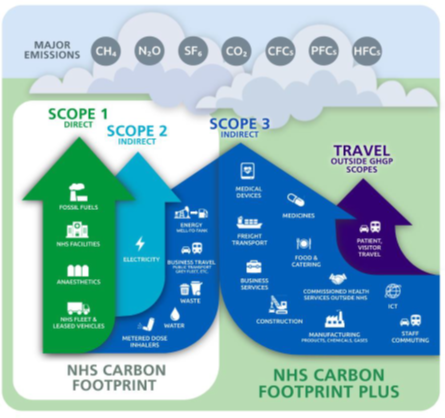
Figure1.
There are various sources of greenhouse gas emissions (see Figure 1) and our targets for reducing these depend on how much direct control our Trust has over these emissions sources. Although there is no requirement for provider Trusts to report carbon emissions within Green Plans, as this data is collected centrally by NHS England (NHSE); we have included a summary of our NHS Carbon Footprint emissions for context and to show the relative scale of emissions in each area.
Carbon Footprint Plus emissions which include those from supply chain and procurement are currently not reported here as they are calculated centrally in a ‘top down’ spend based approach. We aim to improve our data quality and processes over time to enable this to be calculated more accurately through a hybrid model of ‘top down’ spend data plus more accurate ‘bottom up’ data where that data is of sufficient quality. This will be aligned to the methodology set out in the Greener NHS Carbon Footprint Plus – Trust Methodology (March 25). Work to quantify high-level carbon emissions for the Carbon Footprint Plus will take place in 2025/26 and will be published in the annual review of this Green Plan.
We monitor data for relevant emissions sources included within our Carbon Footprint. The following table and graph summarise TEWV’s annual carbon emissions by source, from a 2019/20 baseline year through to 2024/25, with an overall reduction of 4.4% highlighted below and meaning we have significantly more to do, including from site consolidation and decarbonisation:
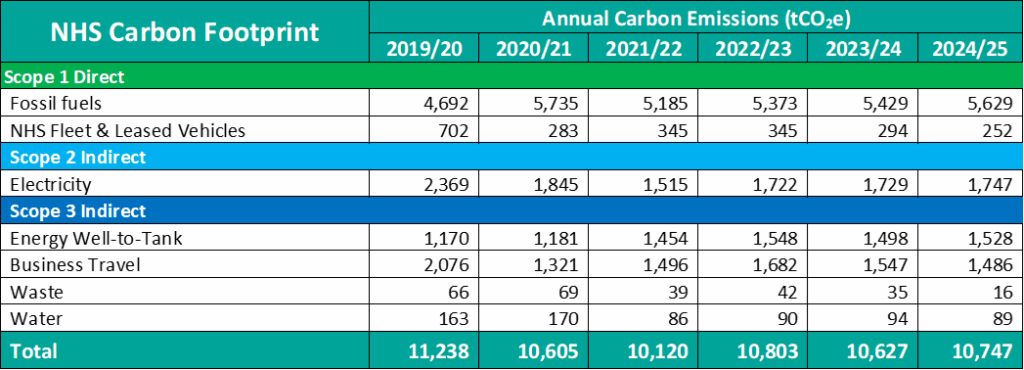
Table 1.
All figures are reported in tonnes of carbon dioxide equivalent (tCO2e). This metric compares the emissions from various greenhouse gases on the basis of their global-warming potential (GWP), by converting amounts of other gases to the equivalent amount of carbon dioxide with the same global warming potential.
- Emissions from energy account for 8,904 tCO2e or 83% of our Carbon Footprint; an increase from 8,231 tCO2e and 73% in 2019/20, due mainly to the use of Combined Heat and Power (CHP) systems for our three largest hospital sites which use fossil fuels to generate electricity and heat on site. These came in to operation in October 2019.
- Emissions from travel have reduced significantly, from 2,778 to 1,738 tCO2e and from 26% to 16% of our Carbon Footprint over the period.
- Emissions associated with waste and water use account for less than 1% of our Carbon Footprint.

Figure 2.
Figure 2 above shows our carbon emissions from the 2019/20 baseline year against NHS targets for achieving net zero by 2040 for the emissions we can control (NHS Carbon Footprint). We have reviewed our methodology for calculating emissions and aligned it with national NHS guidance.
Electricity: Emissions from electricity are reducing through a combination of energy reduction measures, including LED lighting and a decarbonising national grid, and this is set to further improve when our latest projects for LED lighting and solar generation are completed.
Fossil Fuels: Emissions from fossil fuels (mainly gas for heating our buildings) are the largest part of the footprint and have increased since the baseline year, meaning this will be a major area of focus for us in the next few years.
Our three largest hospitals have Combined Heat and Power (CHP) systems which came into full use in 2020 and use gas to generate electricity on site and provide heat to hospital buildings. This is beneficial financially, as it reduces the amount of electricity we purchase but with the continuing decarbonisation of national grid electricity, the carbon impact is less favourable.
We are looking at different options for decarbonising heat including low carbon heating systems and are engaging with partner organisations where heat networks may be feasible. We know that to hit net zero targets we will need to maintain a downward emissions trajectory whilst also being aware that large capital investments will be required to decarbonise our estate.
Business travel is another significant source of emissions and following a period of reduced travel resulting from the Covid pandemic, we are seeing these levels maintained below the baseline but higher than we would like. Going forward we will be working to understand our changing travel patterns and focussing on a combination of reducing distance travelled, reducing carbon emissions from necessary travel, and promoting active travel wherever possible.
Developing this plan
In line with updated guidance from NHSE on refreshing Green Plans, we aim to:
- prioritise interventions that support world-leading patient care and population health, and reduce health inequalities, while tackling climate change and broader sustainability issues.
- plan and make considered investments, while increasing efficiencies and delivering value for taxpayers.
- ensure our organisation supports the ambition to reach net zero carbon emissions, reflecting learning from delivery to date.
We have focused on formalising sub-groups to review current actions and provide evidence of completion and on proposing actions for the refreshed Green Plan. The Trust Energy and Sustainability Manager co-ordinates sub-groups and, along with key leads, provides updates to the quarterly Sustainability Group. Membership of the sub-groups continues to develop and we are looking forward to including staff volunteers in the delivery of the Green Plan. Staff volunteers will be added to a dedicated Teams channel which will provide a forum for exchange of ideas and developing meaningful actions. Monthly Teams sessions will be developed to increase engagement.
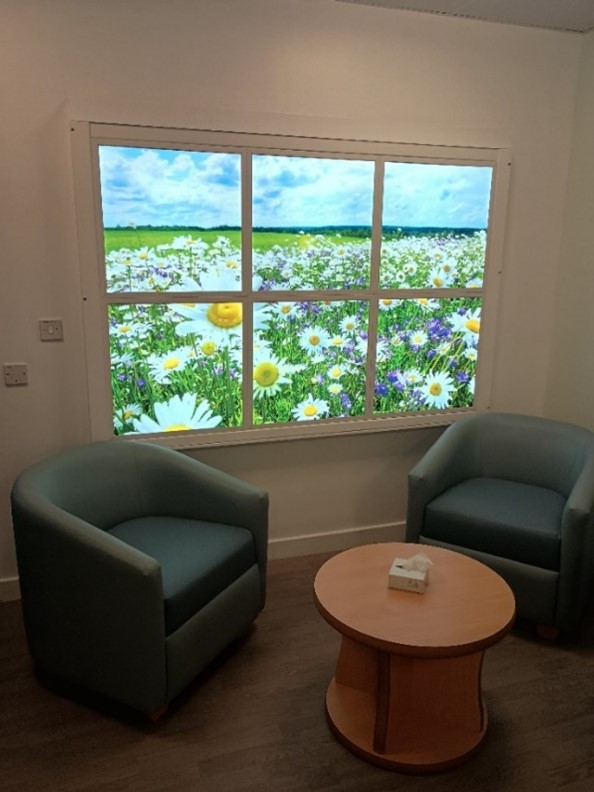
TEWV library – Therapy room at Foss Park Hospital
Working with our partners
We are continuing to work closely with our regional partners to support delivery of the plan.
The Sustainability Team is linked into the following North East and North Cumbria Integrated Care Board (NENC ICB) provider collaborative groups, which have been supported by Health Innovation North East and North Cumbria (HINENC). These groups help to identify actions which can be rolled out across all trusts and are resulting in increased standardisation in areas such as data reporting which ensures consistency of approach:
- Provider Collaborative Sustainability Leads Group
- Energy sub-group
- Travel and transport sub-group
- Procurement sub-group
- Biodiversity and Green Space sub-group
- Waste sub-group
- Adaptation sub-group
Each ICB is required to have a Green Plan and we are linked in to the development of the NENC ICB plan through the above groups.
Net Zero Hubs link us to local and combined authority partners. This is particularly important to us as we operate over a large geographical area and across several local authority boundaries. We are already engaging with these hubs on energy efficiency and heat decarbonisation and alternative sources of funding and will be working more closely with them in coming years.
NHS England Regional Delivery Groups provide a useful forum for engaging with other trusts across the region and keeping up to date with the latest news and best practice.
We are engaging with research partners at the University of York and will look for more opportunities for collaboration, especially in the area of Net Zero clinical transformation.
We encourage staff to engage in sustainability through their own networks and Royal Colleges and will look to promote events and resources where appropriate.
Areas of focus
This section sets out what we have achieved so far, our next steps and the priority actions our Trust will deliver over the next 3 years for each area of focus as follows:
- workforce and leadership
- digital transformation
- net zero clinical transformation
- medicines
- travel and transport
- estates and facilities
- supply chain and procurement
- food and nutrition
- adaptation
For each area of focus we have tried to include timebound actions and associated key performance indicators (KPIs) to support progress tracking but we recognise that some of these will need to be developed over time.
1. Workforce & Leadership

The transition to a net zero NHS will be driven by its people. There is already strong support for a greener future; 9 in 10 staff support the NHS net zero ambition, while 6 in 10 say they are more likely to stay in an organisation taking decisive climate action (YouGov, 2023). We aim to support our staff and leaders to learn, innovate and embed sustainability into working practices. We will continue to build our Green Plan into our strategic planning and governance to ensure that sustainable development is a part of our daily work and how we measure success.
What have we achieved so far?
- Nominated board level lead for Green Plan delivery.
- Reporting on Green Plan progress through Trust Annual Report, quarterly Greener NHS Data Collection.
- Green Plan delivery included in the Board Assurance Framework.
- Increased partnership working with neighbouring Trusts, local and combined authorities to share best practice on energy, travel, waste, biodiversity and adaptation.
- Successful external funding bids for LED lighting, BMS upgrade and solar generation projects
- Created a staff volunteer network to support delivery of the Green Plan.
Our next steps
- Continue to streamline data collection processes and metrics to aid reporting on the Green Plan.
- Continue to identify options to leverage Estates Master Plan opportunities to deliver net zero milestone reductions.
- Identify and action ways to engage patients and community, linking to health inequality and climate action.
- Identify further partnership working opportunities with Net Zero Hubs, Universities and voluntary sector organisations.
- Identify training opportunities to upskill the workforce.
- Promote specialist training opportunities in sustainability.
| Action | KPI | Led by | Reporting |
|---|---|---|---|
| 1.1 Assess workforce capacity and skill requirements for delivering the Green Plan | Workforce capacity assessment | People and culture, Sustainability Team | Six monthly report to Resources and Planning Committee |
| 1.2 Promote and consider setting uptake targets for core training offers set out on Greener NHS Training Hub | Number of training offers promoted | People and Culture, Sustainability Team | Six monthly report to Resources and Planning Committee |
| 1.3 Raise awareness of Green Plan aims at induction | Green Plan included in staff induction | People and Culture, Sustainability Team | Six monthly report to Resources and Planning Committee |
| 1.4 Promote specialist training for staff groups who underpin delivery of Green Plan | Number of staff trained | People and Culture, Sustainability Team | Six monthly report to Resources and Planning Committee |
| 1.5 Quarterly reporting on Green Plan progress | Self-assessment score on Green Plan Support Tool | Sustainability Team | Green Plan Support Tool submissions |
2. Digital Transformation

Strong digital foundations are needed for transforming care by improving access, quality, productivity and reducing carbon emissions but increasing use of digital services can also increase emissions.
Our Journey to Change Digital & Data Strategy will support our Green Plan and net zero ambitions and will use technology to remove waste and inefficiencies.
What have we achieved so far?
- Provision of digital and remote appointments where clinically appropriate, with uptake monitored.
- 2025 Managed Print Contract will reduce printer fleet by 25% by October 2025.
- Baseline Digital Maturity framework assessment completed.
- Data centre energy consumption evaluation project in progress.
- Migration of data systems to cloud-based systems where appropriate – 40 trust systems including IT Service Desk Software (ASM), Trust Risk Management Platform (In Phase), IIC (IBM Cloud) and the Trust intranet are now cloud-based.
Our next steps
- Consider opportunities identified in the digital maturity assessment to embed sustainability in digital services.
- Consider low carbon hosting options, promoting good data hygiene (such as deduplication and archiving) and engaging digital suppliers.
- Reduce data centre energy consumption by optimising server usage, using more energy-efficient hardware, and exploring cloud-based solutions.
- Reduce Paper Based output by 50% by 2030: This means digitising patient records, prescriptions, and other documents to reduce paper waste and the associated environmental impact. Linking our work with the PMO Team to look at ways of working on patient communications.
- Develop a system for tracking and reporting the carbon footprint of IT equipment by 2027 to help the organisation understand its current impact and identify areas for improvement.
| Action | KPI | Led by | Reporting |
|---|---|---|---|
| 2.1 Reduce trust based ‘on premise’ data centre energy consumption by 20% by 2028 | Data centre energy consumption kWh | Digital Team | Digital & Data Leadership Meeting |
| 2.2 Reduce Paper Based output by 50% by 2030 | Units of paper-based output | Digital Team, Clinical Project Management Office Team | Digital & Data Leadership Meeting |
| 2.3 Develop a system for tracking and reporting the carbon footprint of IT equipment by 2027 | Carbon footprint of IT equipment (tonnes CO2e) | Digital Team | Digital & Data Leadership Meeting |
3. Net Zero Clinical Transformation

The NHS is committed to moving to out-of-hospital and digitally enabled care where clinically appropriate, improving prevention of ill health and reducing health inequalities. Net Zero clinical transformation should ensure high quality, preventative, low-carbon care is provided to patients at every stage of their journey.
What have we achieved so far?
- Identified a clinical lead for this area.
- Appointed an Executive Lead for Health Inequalities supporting work with a Consultant Public Health Lead to co-ordinate delivery of our prevention and inequalities approach.
- Developed research funding proposal about how improving access to preventative services in the community and acting earlier in the care pathway can lead to reduced demand for in-patient and hospital services and a reduction in carbon emissions.
- Clinical staff engagement sessions held with Medical Education, Higher Trainees regional event, Health and Justice development event and newsletter for medical staff.
- Promoted Greener Allied Health Professional (AHP) Week 2025.
Our next steps
- Encourage operational and clinical management teams to consider net zero principles in all service change, reconfiguration programmes and pathway redesign.
- Work with Quality Improvement (QI) Lead to integrate Sustainable Quality Improvement (SusQI) into Trust QI processes.
- Promote Special Interest Session for higher trainee doctors working with TEWV Sustainability Committee.
- Engaging staff through committee sub-groups.
- Public Health clinical advisory group will continue to focus on screening, immunisation and delivery of lifestyle advice to support ill health prevention.
- Explore nature-based interventions by mapping available options, linking to third sector, signposting and sharing good practice.
- Link with Allied Health Professionals (AHPs) on public health framework.
- Link with Strategic Quality Standards group.
- Explore ways of capturing outdoor green space related interventions.
| Action | KPI | Led by | Reporting |
|---|---|---|---|
| 3.1 Build on current efforts to reduce health inequalities and improve early intervention, linking this work to potential emissions reductions | Performance against health inequalities objectives | Consultant on Public Health | Annual statement of Health Inequalities Annual report |
| 3.2 Engage staff through committee sub-groups | Log of attendance at committee sub-groups | Clinical lead (sustainability) | Annual report |
| 3.3 By December 2025, incorporate Sus QI into existing QI process | Sustainability included in QI process | Clinical lead (sustainability), QI Lead | Annual report |
| 3.4 By December 2026, carry out an access to green space survey | Completed survey document | Clinical lead (sustainability), Sustainability Team | Annual report |
| 3.5 By March 2026, develop collaboration with University of York research teams | No of collaboration opportunities | Clinical lead (sustainability) | Annual report |
4. Medicines
Medicines account for around 25% of NHS emissions. To date, national guidance and targets have focussed on reducing ‘point of use’ emissions for anaesthetic gases and inhalers but as a mental health trust, these are areas where we have minimal influence. We will focus on optimised use of medicines ensuring that the right choices are made from the point of initiating a medicine and reviewing and deprescribing when needed. We have three dispensing hospital pharmacies providing services across the Trust and our focus is on ensuring that the way we operate these services minimises environmental impact and maximises patient benefit.
What have we achieved so far?
- Formation of a Medicines Green Plan working group led by Pharmacy Team
- Deprescribing guidance added to prescribing guidelines
- Focus on shared decision making and patient information to ensure appropriate medicines are initiated
- Improved communications on medicines through optimisation newsletters and videos
Our next steps
- We will use the Royal Pharmaceutical Society (RPS) Greener Pharmacy Toolkit launched in April 2025 to work through steps to achieve bronze, silver and gold status in reducing our carbon footprint across six domains (People, Clinical Practice, Operations & Strategies, Resource Use, ICT and Travel).
- We will continue to assess waste streams in this area and look for further opportunities to minimise waste arisings.
| Action | KPI | Led by | Reporting |
|---|---|---|---|
| 4.1 By Q2 2025/26, carry out a baseline assessment of three hospital pharmacies against Royal Pharmaceutical Society (RPS) Greener Pharmacy Toolkit | Actions completed in bronze, silver, gold categories across 6 domains | Pharmacy Team | Medicines Management Group Annual report |
| 4.2 Work towards accreditation over the next 3 years and carry out annual self-assessment of hospital pharmacies against RPS Greener Pharmacy Toolkit | Actions completed in bronze, silver, gold categories across 6 domains Number of hospital pharmacies accredited to bronze, silver and gold standard | Pharmacy Team | Medicines Management Group Annual report |
| 4.3 By March 2026, integrate Pharmacy waste stream into clinical waste management arrangements | Regular reporting within clinical waste contract | Pharmacy Team, Sustainability Team | Annual ERIC Return, Greener NHS Waste Dashboard |
5. Travel and Transport
Travel and transport within the NHS covers several areas:
- The NHS Fleet – vehicles that are owned or leased by the NHS
- Business travel – including travel in private vehicles for NHS Business (known as the grey fleet)
- Staff commuting – employee travel to and from home to place(s) of work
The NHS fleet and business travel emissions are part of the NHS Carbon Footprint, as those emissions are under the direct control of the NHS.
Staff commuting emissions are part of the Carbon Footprint Plus, as those emissions are indirectly caused by NHS activity, over which we have less control but can influence.
Work programmes will be developed to address both of these elements.
The NHS NZ Travel and Transport Strategy sets out a roadmap to decarbonise NHS travel and transport, while also providing cost-saving and health benefits. To work towards the aims of this strategy we plan to:
- Develop a sustainable travel plan by December 2026 and incorporate it into the trust Green Plan. This should focus on active travel, public transport and zero emission vehicles supported by a clear understanding of staff commuting.
- Arrange to purchase or enter into new lease arrangements for zero emission vehicles only from December 2027 onwards for our fleet vehicles wherever practical.
- Reduce staff travel emissions through shifts to more sustainable forms of travel and electrification of personal vehicles, including by continuing to provide attractive salary sacrifice arrangements.
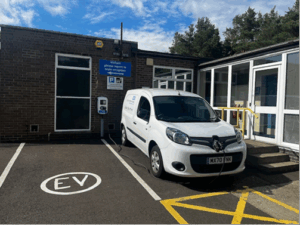
We know that active travel for staff, patients and visitors increases physical activity and can bring many health benefits. Moving to zero emission vehicles will help to improve air quality and reduce ill health. We strongly support the aims of the strategy but also acknowledge that careful consideration must be given to this area to ensure that access to salary sacrifice schemes and green transport initiatives do not exacerbate inequalities for staff.
TEWV library – EV charging at Lanchester Road Hospital
What have we achieved so far?
- We are working with our NENC ICB regional partner trusts to develop a common sustainable travel strategy which can be tailored to each trust’s specific needs.
- We are developing site specific travel plans for sites with larger numbers of staff and have purchased the Modeshift STARS for Healthcare platform to provide a low-cost way of managing these plans and monitoring how staff travel to work. This is a good example of standardisation across our ICB partners and joint working has led to improved costs for all trusts taking part.
- Our network of electric vehicle (EV) charging points has increased to 80 across the Trust and supports staff who want to switch to an EV. Availability of charge points for Trust staff has improved since a tariff was introduced, following wide consultation, in April 2024.
- Our lease and salary sacrifice scheme operated by Knowles Fleet is now made up of 33% zero emission full electric vehicles, 30% low emission vehicles (hybrid and plug-in hybrid) and 37% combustion engine vehicles.
- Additional EV charging points have been installed to support estates and facilities vehicle charging and enable the switch to EVs as leases fall due for renewal.
- Our business use only fleet currently has 15 zero or low emission vehicles with further vehicles on order.
- We continue to improve our data collection processes for travel data to help us to monitor progress including collating fuel card data.
- A Cycle to Work Scheme is in place across the Trust.
Our next steps
- Develop a policy with our fleet provider to review zero emission vehicle options for all new fleet (business use only) vehicle leases.
- Work with our fleet provider to develop a policy for limiting access to higher emission vehicles through the lease and salary sacrifice scheme.
- Continue to monitor travel data annually and complete the Greener NHS Fleet Data collection in May each year.
- Improve granularity of reporting for business travel carried out in staff owned vehicles (grey fleet) to increase accuracy of carbon emissions reporting.
- Develop site specific travel plans for the ten sites with the largest staff numbers.
- Continue to work with local and combined authorities on joint funding opportunities for travel initiatives.
| Action | KPI | Led by | Reporting |
|---|---|---|---|
| 5.1 By March 2026, develop programme for switching fleet (business use only) vehicles to zero emission options from December 2027 | % of fleet vehicles which are zero emission | Travel and transport sub-group | Greener NHS Fleet Data Collection |
| 5.2 Increase number of staff accessing sustainable travel incentives (e.g. cycle to work scheme) | Number of staff accessing travel incentive schemes | Travel and transport sub-group | Annual report |
| 5.3 By September each year, conduct trust wide staff travel survey and report modal split | Modal split % | Travel and transport sub-group | Quarterly Greener NHS Data Collection |
| 5.4 Continue to monitor and report travel data annually | Fleet carbon emissions (tonnes) Lease/salary sacrifice vehicle carbon emissions (tonnes) Grey Fleet vehicle emissions (tonnes) | Travel and transport sub-group | Greener NHS Fleet Data Collection |
| 5.5 By March 2026, develop policy with Fleet provider on limiting higher emission vehicles | Policy published | Travel and transport sub-group | Annual report |
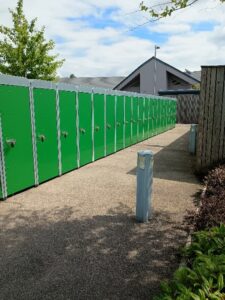
TEWV library – Cycle lockers at Foss Park Hospital
6. Estates and facilities
In line with Our Journey to Change, our vision for the estate is to:
Minimise our environmental impact by :
- Promoting biodiversity
- Reducing the physical footprint, cost, and energy requirements of our estate
- Have Trust wide ownership of the Green Plan
- Work together in new ways to enable overall space reduction (despite increases in staff)
- Adopt innovative green solutions which reduce our carbon emissions and make a positive impact to address climate change.

The key areas of focus are:
- Better, smaller, greener buildings
- Transformed services in smarter places
- Adding value and ensuring efficiency
These aims will help to address decarbonisation, adaptation to climate change and make better use of resources and are fully aligned with this Green Plan and with the Estates Masterplan.
We are following the principles set out in the Estates Net Zero Delivery Plan and due to the wide area of focus that this section covers, we have separated the Estates and Facilities section into targeted areas for action.
Estates and Facilities (Energy & Water)
A key part of our Trust Green Plan is to reduce our building energy and water consumption and carbon emissions to meet our NHS Net Zero by 2040 targets. It will also reduce what we spend on our energy bills. Capital funding is limited, and the bidding process is extremely competitive.
In line with the Estates Net Zero Delivery Plan, we are continuing to work on a four-step approach to decarbonise our estate by 2040 as shown in Figure 3:
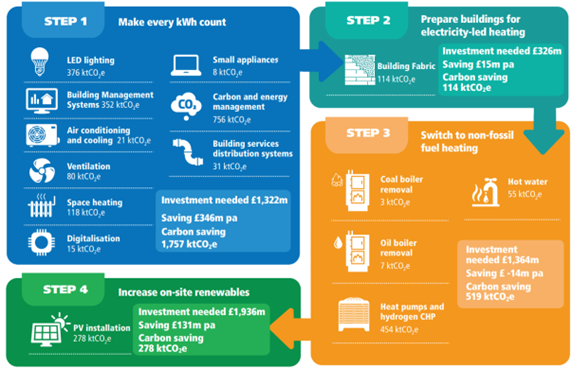
Figure 3. Estates Net Zero Delivery Plan – 4 step approach. This includes indicative numbers to illustrate the scale of the challenge to decarbonise the NHS estates by 2040. These are not actuals.
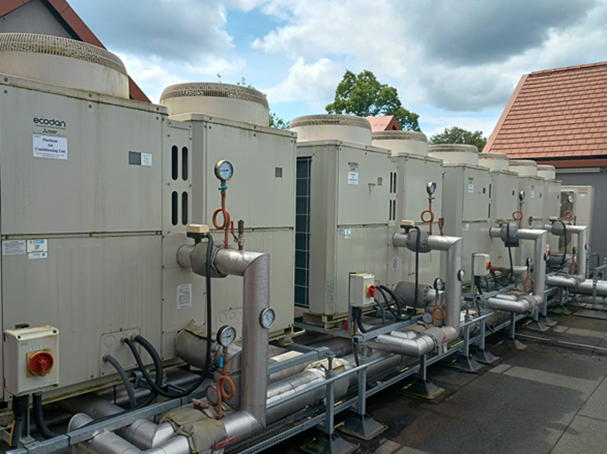
TEWV library – Air Source Heat Pumps at Foss Park Hospital.
What have we achieved so far?
- Water main replacement works have commenced at Roseberry Park hospital, to address leaks due to site defects and reduce water consumption, with work scheduled to complete in September 2025.
- Successful £790k NHS Energy Efficiency Fund (NEEF) bid in 2023/24 to install LED lighting upgrades across five inpatient sites.
- Successful £350k NEEF bid for LED lighting upgrades at Roseberry Park Hospital and a Building Management System (BMS) upgrade at Cross Lane Hospital.
Our next steps
- A £1.2 million solar project for Roseberry Park and Acklam Road hospitals will be delivered by March 2026 and will increase our on-site renewable generation from <1% currently to around 10% of our total electricity requirement for the Trust.
- Continue to engage with partners on Heat Network feasibility studies for Roseberry Park, Foss Park and Lanchester Road hospitals.
- Develop business cases for low-carbon heating at priority sites with end-of-life heating plant.
- Prepare further proposals for LED lighting upgrades and other energy efficiency measures on Core Estate.
| Action | KPI | Led by | Reporting |
| 6.1 By March 2028, develop a heat decarbonisation plan, which includes identifying and prioritising the phasing out of all existing fossil-fuel primary heating systems by 2032. | % of sites with a heat decarbonisation plan Carbon emissions from fossil-fuel-led heating sources (tonnes) | Estates & Facilities | Annual ERIC Return |
| 6.2 Increase LED lighting coverage year on year | % LED lighting coverage across Core Estate | Estates & Facilities | Annual ERIC Return |
| 6.3 Reduce water consumption year on year | Water consumption m3 | Estates & Facilities | Annual ERIC Return |
| 6.4 By March 2026, have a strategy for maximising on site solar generation | On site solar generation kWh | Estates & Facilities | Annual ERIC Return |
| 6.5 By March 2027, have a metering and sub-metering strategy in place for electricity, gas and water | % sites actively using sub-metering | Estates & Facilities | Annual report |
Estates and Facilities (Waste & Recycling)
We produce and manage seven main categories of waste in line with guidance set out in Health Technical Memorandum (HTM) 07-01 (2022 edition):
- Clinical and offensive
- General waste
- Dry Mixed recycling
- Waste electrical and electronic equipment (WEEE)
- Confidential waste
- Food waste
- Ad hoc waste streams including metal, lamps, IT equipment, batteries, waste cooking oil.
Sustainable waste management means using resources more efficiently, reducing the amount of waste produced and, where waste is generated, dealing with it in a way that will help to achieve circularity and sustainable development.
The waste hierarchy prioritises the different steps that should be taken to manage waste, with step 1 being the optimal solution and step 7 the last resort.
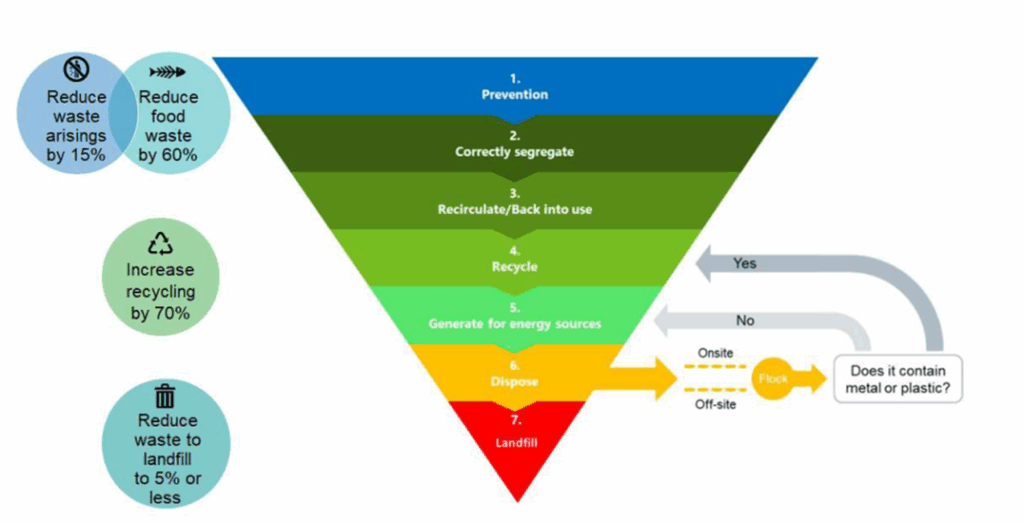
Figure 4. Waste management hierarchy and NHS 2030 targets from HTM 07-01
What have we achieved so far?
- Improved waste segregation by moving more clinical waste into the offensive stream in line with the NHS Clinical Waste Strategy (2023). The target for all NHS providers to achieve clinical waste segregation targets of 60:20:20 offensive, alternative treatment and offensive and high temperature waste by 2026 has been achieved early in 2024/25.
- Appointment of a dedicated waste manager role within Estates and Facilities Team.
- Increased non-healthcare waste recycling rate.
- Zero domestic waste to landfill in 2024/25.
- Reduction in single use items in catering.
- Food waste collection system introduced in April 2025.
- Carried out waste training for key staff including Hotel Services and Infection Prevention and Control.
- Improved data collection processes to aid monitoring of waste volumes.
Our next steps
- Monitor food waste volumes and identify trends.
- Focus on reducing overall waste volumes and aligning with the waste hierarchy.
- Further work to improve clinical waste segregation processes.
- Consider further training opportunities through different media for key staff.
| Action | KPI | Led by | Reporting |
|---|---|---|---|
| 6.6 Achieve 60:20:20 clinical waste ratio (or better) | Offensive waste (tonnes) Alternative treatment waste (tonnes) High temperature incineration waste (tonnes) | Estates & Facilities | Annual ERIC Return, Greener NHS Waste Dashboard |
| 6.7 Target year on year reduction in clinical waste volume | Offensive waste (tonnes) Alternative treatment waste (tonnes) High temperature incineration waste (tonnes) | Estates & Facilities | Annual ERIC Return |
| 6.8 Target year on year reduction in food waste volume | Food waste (tonnes) | Estates & Facilities | Annual ERIC Return |
| 6.9 Target year on year reduction in non-healthcare waste volumes | Domestic waste (incineration) tonnes Domestic waste (recycling) tonnes | Estates & Facilities | Annual ERIC Return |
Estates and facilities (Capital Projects)
The built environment of the NHS influences both the quality of our care and our environmental impact. Buildings have a significant environmental impact in terms of emissions resulting from the use of gas, electricity, and water, so improving the energy efficiency of a building is key to reducing these impacts. Our Estates Masterplan provides a framework to progress the infrastructure vision for our estate, allowing us to play our part in system planning, make informed building decisions and respond to opportunities as they arise.
We will continue to focus on:
- Integrating sustainability into our Strategic Estates Planning and considering the carbon impact of our building provision.
- Ensuring building energy efficiency standards are considered for new builds and refurbishments.
- Ensuring construction suppliers are aligned to our net zero commitments through appropriate tender processes.
- Using low carbon substitutions and product innovation where available.
- Ensuring that all applicable new building and major refurbishment projects are compliant with the NHS Net Zero Building Standard.
What have we achieved so far?
- Implemented building energy efficiency standards within new build and refurbishment projects within the constraints of mental health requirements for buildings.
- Included social value and sustainability questions in relevant procurements, including through the recent procurement for Phase 2 of the Roseberry Hospital rectification programme.
- Rationalised the building estate where appropriate. An example of this is the provision of Hummingbird House in Harrogate which consolidates services from three smaller properties into one building.
- We have continued to work with clinical teams, patients, staff, regional partner organisations and local communities on developing our estates provision.
Our next steps
- We will model scenarios around the changing estate and will include mapping of carbon impacts of different scenarios for Core, Flex and Tail estate alongside financial impacts.
- Explore options for virtual wards and community hubs.
- Develop a checklist for refurbishment projects to include sustainability criteria.
| Action | KPI | Led by | Reporting |
|---|---|---|---|
| 6.10 By March 2026, develop a methodology for capturing carbon impacts of different scenarios. | Methodology included in modelling EMP template | Capital Planning , Sustainability Team | Six monthly report to Resources and Planning Committee |
| 6. 11 By March 2027, develop a process for evaluating options for virtual wards and community hubs | Process document in use | Capital Planning | Six monthly report to Resources and Planning Committee |
| 6.12 By December 2026, develop a sustainability checklist for refurbishment projects. | Checklist in use | Capital Projects , Sustainability Team | Six monthly report to Resources and Planning Committee |
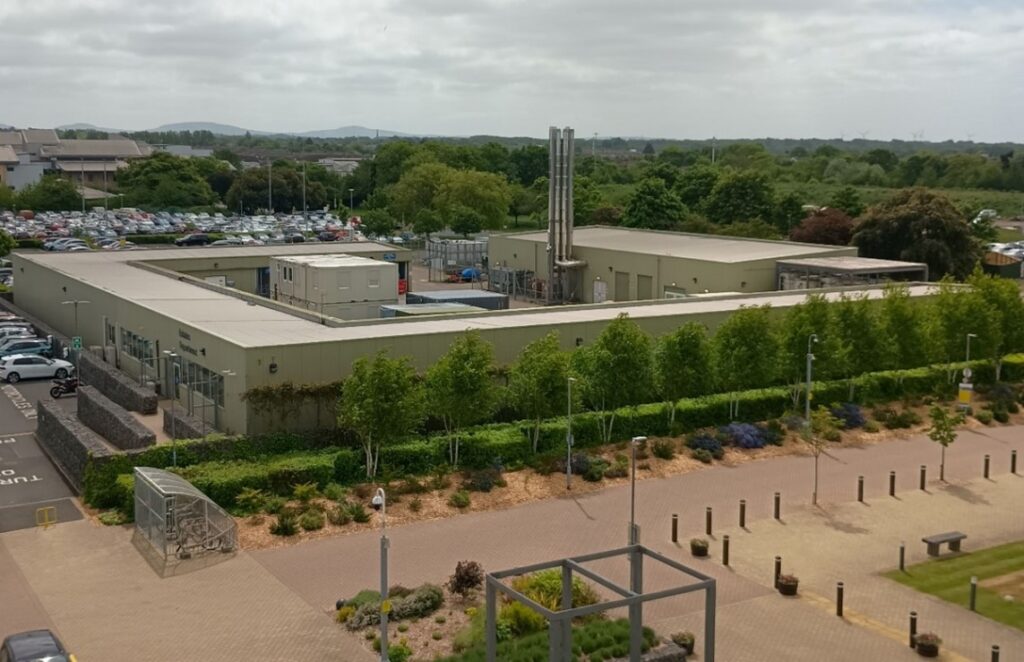
TEWV library – Energy Centre at Roseberry Park Hospital
Estates and facilities (Biodiversity & Greenspace)
Access to green spaces has positive mental and physical health benefits. We aim to create healthy outdoor spaces for the hospital community to enjoy, embed nature into hospital care and rehabilitation, build a climate-resilient estate through nature-based solutions and support local wildlife to thrive through creation and connectivity of habitats.
What have we achieved so far?
- Trees provided by NHS Forest were planted in March 2025 in the ‘secret garden’ area at Foss Park Hospital. The event was facilitated by Natural England and involved patients, staff and volunteers.
- Trial of some ‘No Mow May’ areas at three sites has led to a wider adoption of unmown grassed areas to provide more varied habitat for pollinating insects and wildlife.
- Woodland habitat improvements at Lanchester Road hospital.
Our next steps

- Develop guidance for clinical staff on creating safe, accessible green space areas for patients.
- Work with Natural England, staff, patients and volunteers to co-create Foss Park courtyard wellbeing gardens.
- Develop signage and communications around the biodiversity benefits of reduced mowing regime areas.
- Review the potential for improved management of green waste arising on larger hospital sites.
- Identify further opportunities for habitat creation through surveys.
- Work with partners including NHS Forest to obtain funding for tree and hedgerow planting projects.
| Action | KPI | Led by | Reporting |
|---|---|---|---|
| 6.13 Increase unmown areas of amenity grassland year on year | Grassland area unmown (m2) | Estates & Facilities Sub-group | Annual report |
| 6.14 By March 2027, develop a Biodiversity and Greenspace Strategy | Published strategy in place | Estates & Facilities Sub-group | Annual report |
| 6.15 Annual native tree/hedgerow planting programme | Number of trees planted Hedgerow planted (metres) | Estates & Facilities Sub-group | Annual report |
| 6.16 Carry out biodiversity surveys on key sites | Survey results | Estates & Facilities Sub-group | Annual report |
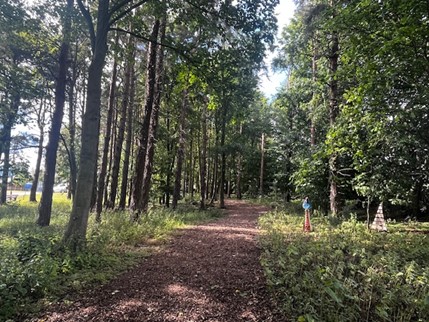
TEWV Library – Lanchester Road Hospital woodland walk.
7. Supply Chain & Procurement
TEWV is committed to engaging with our suppliers to meet our Green Plan requirements. The Trust has partnered with County Durham and Darlington’s (CDD) subsidiary managed Procurement Services to ensure that products and services procured are compliant with legislation and consistent with our efforts to improve our environmental sustainability and achieve cost reductions.
We can reduce emissions from our supply chain in three ways:
- more efficient use of supplies,
- low carbon substitutions and product innovation, and
- by ensuring our suppliers are decarbonising their own processes.
The NHS Net Zero Supplier Roadmap below outlines steps which our suppliers must follow to align with our Net Zero ambitions.
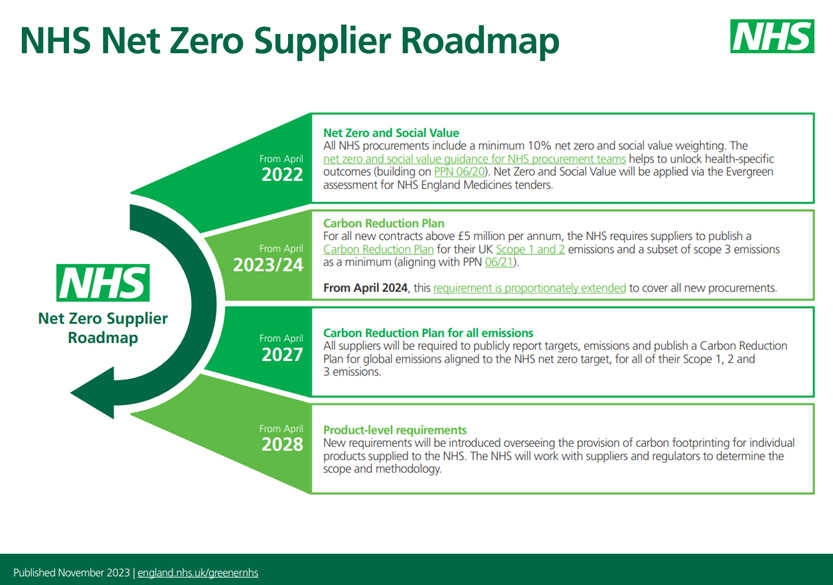
Figure 5. NHS England Net Zero Supplier Roadmap.
What have we achieved so far?
- All procurements include a minimum 10% net zero and social value weighting.
- We have worked with teams to strengthen sustainability questions for suppliers within tender processes for contracts including domestic services, pest control services, washroom services, and rectification works for Roseberry Park hospital under new rules from April 2024 which extended the requirement for new contracts to have a Carbon Reduction Plan detailing their carbon emissions.
- Modern Slavery questions are incorporated into all procurement exercises undertaken through CDD Procurement Services and NHS Supply Chain.
- We ensure the purchase of 100% closed loop recycled paper.
- The Sustainability Team provides support on net zero and sustainability questions within the tender process for trust staff as both buyers and providers of services.
Our next steps
- We will embed NHS Net Zero supplier roadmap requirements into all relevant procurements and ensure they are monitored through KPIs.
- We will encourage suppliers to go beyond minimum requirements and consider engaging with the Evergreen Sustainable Supplier Assessment to support a single conversation between the NHS and its suppliers on sustainability.
- We will look at ways to reduce reliance on single use products and consider how to safely build this work into clinical development.
- We will develop our data collection processes to enable more granular reporting and identify opportunities for financial and carbon savings.
| Action | KPI | Led by | Reporting |
|---|---|---|---|
| 7.1 Include NZ Supplier Roadmap requirements in relevant procurements | Number of procurements | Supply Chain & Procurement sub-group | Quarterly Greener NHS Data Collection |
| 7.2 By March 2026, develop data collection process for calculating carbon emissions from procurement by sector type | Carbon emissions (tonnes) | Supply Chain & Procurement sub-group | Annual report |
| 7.3 Develop actions to identify and reduce single use products | Action plan in place | Supply Chain & Procurement sub-group | Annual report |
8. Food and Nutrition
It is estimated that food and catering services in the NHS produces 1,543 ktCO2e each year, equating to approximately 6% of total emissions. Healthier, locally sourced food can improve wellbeing while cutting emissions related to agriculture, transport, storage and waste across the supply chain and on NHS estate.
Our trust has a particular challenge in that we cover a wide geographical area with different clinical, rehabilitation and outpatient and staff settings, meaning that approaches to sustainability need to be nuanced to each particular area and local practice. This however provides a great opportunity for innovative and collaborative working within each clinical area.
What have we achieved so far?
- We limit sugary drinks sales and implement healthy eating practices in our cafes and vending machines by offering less processed and healthy options
- We now measure food waste in line with ERIC guidelines for reporting and will develop reduction targets.
- We continue to work towards implementing the National Standards for healthcare food and drink including the BDA Nutrition and Hydration Digest developed by the Association of UK Dietitians.
- A member of the Trust’s Dietetic Leadership team is leading on Sustainability workstreams within the Trust from a dietetic perspective.
- We have a trust Menus Group overseeing inpatient food and menu options, with attendance from key staff from Hotel Services and Dietetic teams.
- The Trust meets the recommendation by the National Institute for Health and Care Excellence (NICE) to have a dedicated Nutrition and Hydration Steering group as part of the Fundamentals of Holistic Care Clinical Advisory Group.
- We held a Green Plan awareness session at a Trust Dietetic Learning Network Event.
- Key staff members attended an NHS England training session on Sustainability and the NHS and are sharing this learning across teams to promote healthy and sustainable diets.
Our next steps
- We will continue to measure food waste and will set reduction targets.
- We will consider opportunities to make menus healthier and to lower carbon by supporting the provision of seasonal menus high in fruits and vegetables and low in heavily processed foods.
- We will look to implement the learning and key standards of the British Dietetic Association One Blue Dot Campaign, aiming to provide healthy and sustainable diets that meet nutritional guidelines
- We will develop a business case to request funding for a Food Services Dietitian. The Independent Review of NHS Hospital Food (2020) and the National Standards for Healthcare Food and Drink (2022) specify that every NHS organisation should have a food service dietitian. This role should be the main interface between catering and clinical services, ensuring constant communication and co-operation between the relevant teams, as well as leading on the food and drink strategy.
- We will review the business case for a digital meal system to enable accurate meal planning and reduce food waste.
- We will look into menu design to promote low carbon, more sustainable options, and also implement this into our cafes and restaurants
| Action | KPI | Led by | Reporting |
|---|---|---|---|
| 8.1 By June each year, measure and report on food waste by type | Weight (tonnes) of food waste, with further break down by spoilage, production, unserved and plate waste | Hotel Services | Annual ERIC return |
| 8.2 By March 2026, develop food waste reduction targets | % food waste reduction | Hotel Services, | Annual report |
| 8.3 By December 2026, embed sustainability considerations into menu review process | Evidence from review process | Hotel Services, | Trust Menu Group |
| 8.4 Review business case for digital meal ordering system | Digital meal ordering system in place at one or more sites | Hotel Services | Quarterly Greener NHS Data Collection |
| 8.5 By December 2025, develop business case for Food Service Dietitian | Evidence from review process | Hotel Services, Dietetic Professional Head and Sustainability lead | Fundamentals of Holistic Care Clinical Advisory Group |
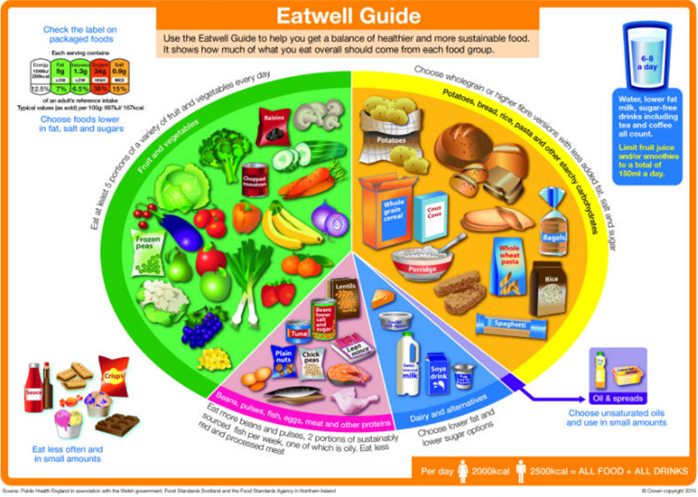
Figure 6. Eatwell Guide produced by Public Health England and the Food Standards Agency
9. Adaptation
Climate change threatens the ability of the NHS to deliver essential services in both the nearer and longer term. This means we need to build in resilience and adaptation into business continuity and longer-term planning to avoid climate-related service disruptions. We will identify risks and develop actions to prepare for severe weather events, and to improve climate resilience of our sites and services, including digital services.
What have we achieved so far?
- The Trust has developed a generic risk within the Board Assurance Framework for failure to deliver the Green Plan which includes failure to comply with environmental legislation, adverse impacts of the changing climate, and failure to meet carbon reduction targets.
- Climate change resilience training for key staff in EPRR and Sustainability teams.
- Enhanced reporting, under the Taskforce on Climate Related Financial Disclosures (TCFD) requirements, within the Trust’s annual report.
- Participation in NENC ICB Provider Collaborative Adaptation workshops to collectively progress and standardise the climate change risk assessment process.
Our next steps
- Integrate adaptation provisions within NHS Core Standards of emergency preparedness, resilience and response (EPRR).
- Carry out baseline Climate Adaptation Framework Maturity Assessment.
- Develop EPRR Risk Register.
- Carry out Climate Change Risk Assessment (CCRA) using NHS CCRA tool .
- Develop a Climate Change Adaptation Plan.
| Action | KPI | Led by | Reporting |
|---|---|---|---|
| 9.1 By Dec 2026, develop Climate Change Risk Assessment (CCRA) for the Trust | % of sites covered by CCRA | EPRR, Estates, Sustainability | Annual report TCFD section |
| 9.2 By March 2026, develop EPRR Risk Register | EPRR Risk Register in use | EPRR lead | Annual report TCFD section |
| 9.3 By Q3 25/26, define Incident Reporting risk categories | Number of climate related risk categories on In Phase system | EPRR lead, H&S team | Annual report TCFD section |
| 9.4 By Dec 2025, carry out Climate Adaptation Framework baseline maturity assessment | Baseline score | EPRR lead | Annual report TCFD section |
| 9.5 By Mar 2027, produce a Climate Adaptation Plan | Climate Adaptation Plan published | EPRR, Estates, Sustainability | Annual report TCFD section |
Governance and accountability
- The Chief Executive has assigned Net Zero leadership to the Executive Director of Finance, Estates and Facilities, with operational responsibility delegated to the Director of Estates, Facilities and Capital who has recruited an Energy and Sustainability Manager to develop and implement the Green Plan and report against related targets.
- The Sustainability Group meets quarterly and provides a forum for directorate and corporate team leads to:
- report on progress against the trust Green Plan, and
- share learning on the key areas including systems leadership and workforce, sustainable models of care, digital transformation, travel and transport, waste reduction, estates and facilities, medicines, supply chain and procurement, food and nutrition and adaptation.
- The Trust provides six-monthly updates on Green Plan, Sustainability and Net Zero progress, which is issued to the Trust Net Zero Lead, Executive Directors Group, and Resources and Planning Committee.
- We will review and update the Green Plan at least annually to consider progress made and to identify any new priorities, guidance, technology and other enablers.
- We will continue to update our ICB partners on progress and report into NHS England data collections as requested.
- An annual summary of progress on delivery of this Green Plan will be reported to the Resources and Planning Committee and published within the Trust annual report. This will include actions taken and planned and quantitative progress data against defined targets and will provide a useful assessment of delivery successes and any risks to future delivery.
How can I get involved?
The Green Plan is a living document and will evolve over time. As such, actions and targets may be revised where necessary. Resources will be allocated to achieve our goals and deliver sustainable care. We always look to achieve the ‘quick wins’ first, but we acknowledge that significant investment will be required in future years, especially in making our buildings net zero carbon and resilient to climate change.
Climate change poses many threats to our care population and how we deliver care. This Green Plan will enable us to become an adaptable and resilient organisation. It will help steer our direction of travel with other local anchor institutions and bolster our ability to provide a continued critical service.
Our dedicated workforce is core to our care provision and delivery of this Green Plan. With the necessary structures in place, it will be our people and service users who will drive the changes to make us a more sustainable organisation. We will continue an open dialogue with all stakeholders to improve our Green Plans and the care we deliver.
Have you got any suggestions or comments about our Green Plan? We’d love to hear them!
If you’d like to be involved with the delivery and improvement of our Green Plan, please contact our Energy and Sustainability Manager [email protected] or see our information about caring for the environment for more information.